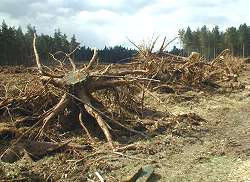 The potential risk of H. annosum infection in your crop depends on:
The potential risk of H. annosum infection in your crop depends on:
- Site hazard
A combination of soil type and climate.
H. annosum grows fastest in stumps in soils that are well-drained and warm.
Infection is less serious on peaty soils, especially in cold areas with high rainfall, because the fungus grows very slowly and does not transfer so readily from infected stumps to live trees.
- Site risk
Determined by management strategies.
High-risk strategies include thinning susceptible species regularly and hard, no stump treatment.
Low-risk strategies include no thinning, using stump treatment, planting hardwoods
If your site is at high risk of infection
(e.g. warm climate, well-drained soil)
There are two control options depending on the crop species involved:
- On pine species – biological control using PG Suspension or urea (37% w/v)
- On any other species – urea (37% w/v)
In very badly affected sites de-stumping following clear-felling is an effective but expensive method of reducing infection in the following crop.
If your site at very LOW risk of infection
(e.g. cold, wet climate, peat soil)
There is no need to use stump treatment.
Its is recommended to use stump treatment.
 The potential risk of H. annosum infection in your crop depends on:
The potential risk of H. annosum infection in your crop depends on: